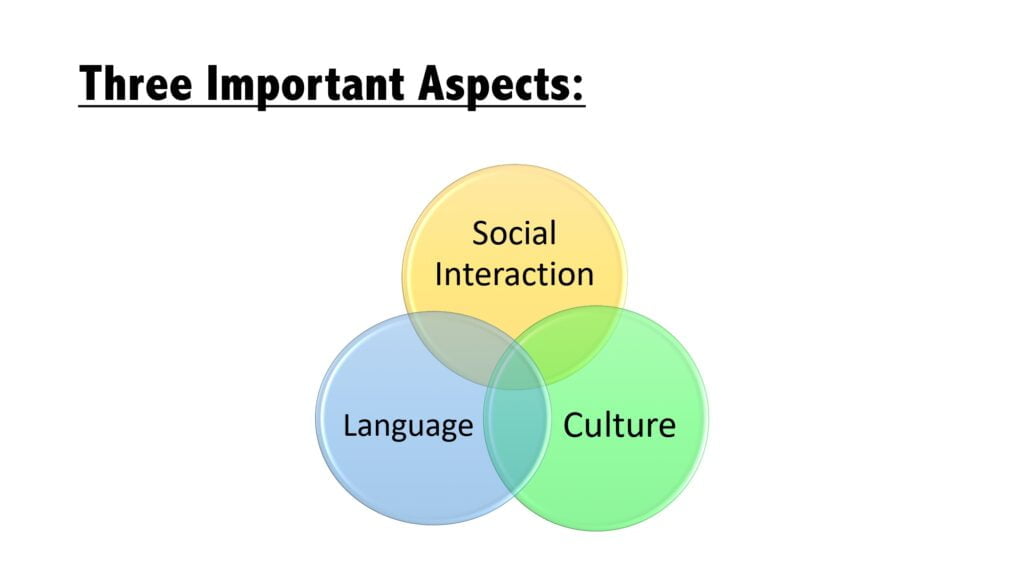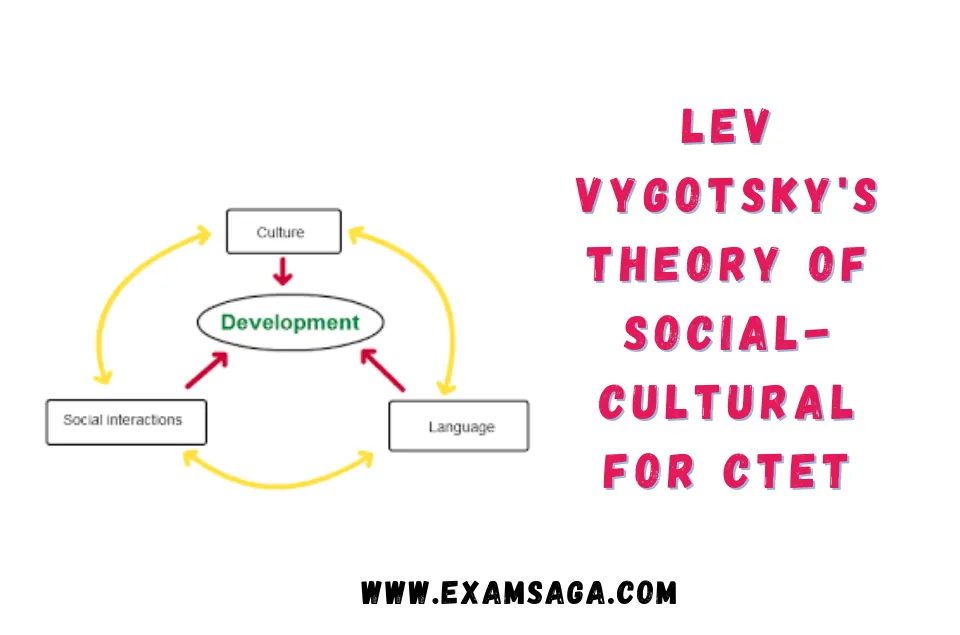Get a detailed Lev Vygotsky’s theory of cognitive development for Ctet and other teaching examinations.
Lev Vygotsky’s Theory of Cognitive Development
• A Russian Psychologist.
• A Social Constructivist.
• Focused on socio-cultural aspects
Lev Vygotsky’s theory of cognitive development is called a social-cultural theory . This theory implies the idea that social interaction, society and language play a crucial role in the development of learners’ cognitive ability.
Three Important Aspects of Lev Vygotsky’s theory

Vygotsky and Language
Vygotsky believed that language develops from social interactions.
Vygotsky viewed language as man’s greatest tool, a means for communicating with the outside world.
Three forms of language:
- Social speech: which is external communication used to talk to others (from the age of 2).
- Private speech: (from the age of 3) which is directed to the self and serves an intellectual function.
- Silent inner speech: finally private speech goes underground, diminishing in audibility as it takes on a self-regulating function and is transformed into silent inner speech (from the age of 7).
Scaffolding
More Knowledgeable Other (MKO)
More Knowledgeable Other (MKO) is the person who has a better understanding of the concept, idea or knowledge. MKO can be a teacher, peer, parent etc.
Example 1
• If a teacher who has a better understanding of the concept and helps the children to solve problems, then the teacher is the MKO here
• If a peer has a better understanding of the PlayStation game and helps the friend to play better, then the peer is the MKO
• In fact, the More Knowledgeable Other need not be a person at all. Some companies, to support employees in their learning process, are now using electronic performance support systems
Zone of Proximal Development
• This is an important concept that relates to the difference between what a child can achieve independently and what a child can achieve with guidance and encouragement from a skilled partner
• It is also called ZPD
Example 1
• The example we discussed above where the child was not able to solve the jigsaw puzzles but was able to do with the help of father is an example of ZPD
• In this case child knew that blocks need to be connected but he did not know how to connect them. The difference between them is called ZPD
•MKO helps the child cross the ZPD and achieve something which cannot be achieved alone. Father is the MKO here.
• ZPD is the area where guidance or instruction should be given with care as child would need direction and encouragement
• Vygotsky believed that teachers should engage children in collaborative learning as children can learn from each other and cross the ZPD
Scaffolding
• The assistance which is given by the MKO to the child to cross the ZPD is called Scaffolding
• Scaffolding helps learners complete the task which was not possible to complete individually
• Scaffolding should be decreased gradually when the child starts to learn the concepts.
Mcq on Lev Vygotsky’s Theory
Question 1. An educator wants to help his students understand various views of a situation. He offers his students several chances to discuss the situation in different group settings. As per Vygotsky’s point of view, his students will _________ the various views and develop different perspectives of the situation themselves.
(A) Internalize
(B) Operationalize
(C) Construct
(D) Diverge
Answer: (A)
Question 2. What does the Zone of Proximal Development (ZPD) represent in Vygotsky’s theory?
(A) Tasks that are too difficult for children, but which can be accomplished by them through adult support.
(B) A teacher’s interference that hinders the learning of her students.
(C) Cognitive development is the proximal zone of growth.
(D) The learning that takes place only in a formal setting.
Answer: (A)
Question 3. Which of the following is correct with respect to the Zone of Proximal Development (ZPD) discussed in Vygotsky’s socio-cultural theory?
(A) It is that phase where the maximum development takes place.
(B) It is that phase of development where a student takes full responsibility for his/her own learning.
(C) It refers to a context in which students can almost perform a task on their own with the right level of support.
(D) It is the point in the learning cycle when the teacher can withdraw the support provided to a student.
Answer: (C)
Question 4. Which of the following thinkers while considering children active seekers of knowledge, stresses the role of cultural and social content in their thinking?
(A) Jean Piaget
(B) Edward Thorndike
(C) JB Watson
(D) Lev Vygotsky
Answer: (D)
Question 5. While attempting to solve a jig-saw puzzle, 5-year-old Ketan says to himself, “I must find the yellow piece, the round one, not the square one, because it will come here and complete this cap”.
Vygotsky refers to such type of talk as
(A) Scaffolding
(B) Self-centered speech
(C) Private speech
(D) Thinking aloud
Answer: (C)
Question 6. As per Vygotsky, when adults alter the support in order to improve the child’s existing level of performance, it’s known as
(A) Reciprocal teaching
(B) Scaffolding
(C) Assimilation
(D) Accommodation
Answer: (B)
Question 7. Who among the following is of the view that it’s essential to understand the impact of the cultural framework and social processes on a child’s thinking?
(A) Lawrence Kohlberg
(B) BF Skinner
(C) Jean Piaget
(D) Lev Vygotsky
Answer: (D)
Question 8. The teacher observed that Vikrant couldn’t find the answer to a question on his own. However, he is able to do so under peer or adult guidance. What is this guidance known as?
(A) Decentration
(B) Zone of Proximal Development
(C) Positive Transfer of Learning
(D) Scaffolding
Answer: (D)
Question 9. A significant point of distinction between Piagetian and Vygotsky’s perspectives relates to
(A) their criticism of behaviouristic learning.
(B) the role played by a nurturing environment in child development.
(C) how they view language and thought.
(D) the way they view children as active creators of knowledge.
Answer: (C)
Question 10. As per Vygotsky, what is the Zone of Proximal Development (ZPD)?
(A) The zone outlining the guidance provided to a child by an adult.
(B) The gap between what children can do on their own and with support.
(C) The type and quantum of assistance provided to children to help them achieve their potential.
(D) The tasks that children can accomplish independently, without any external support.
Answer: (B)
-
Ctet Jan 2024 Question Paper with Answer key Pdf Free Download [All Shifts]
![Ctet Jan 2024 Question Paper with Answer key Pdf Free Download [All Shifts] 5 Ctet Jan 2024 Question Paper with Answer key Pdf Free Download [All Shifts]](https://examsaga.com/wp-content/uploads/2024/11/Ctet-Jan-2024-Question-Paper-with-Answer-key-Pdf-Free-Download.webp)
WhatsApp Group Join Now Telegram Group Join Now Instagram Group Join Now Download CTET Jan 2024 Question Paper … Read more
-
CTET January 2024 Admit Card Out: Direct Link – CTET Paper 1 and 2 Admit Card @ctet.nic.in

WhatsApp Group Join Now Telegram Group Join Now Instagram Group Join Now CTET January 2024 Admit Card has … Read more
-
CTET January 2024 Exam City Intimation Slip, Download Link – CTET Paper 1 and 2 Pre Admit Card @ctet.nic.in

WhatsApp Group Join Now Telegram Group Join Now Instagram Group Join Now CTET January 2024 Exam City Intimation … Read more
